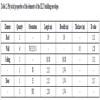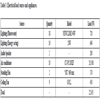- Home
- About Journals
-
Information for Authors/ReviewersEditorial Policies
Publication Fee
Publication Cycle - Process Flowchart
Online Manuscript Submission and Tracking System
Publishing Ethics and Rectitude
Authorship
Author Benefits
Reviewer Guidelines
Guest Editor Guidelines
Peer Review Workflow
Quick Track Option
Copyediting Services
Bentham Open Membership
Bentham Open Advisory Board
Archiving Policies
Fabricating and Stating False Information
Post Publication Discussions and Corrections
Editorial Management
Advertise With Us
Funding Agencies
Rate List
Kudos
General FAQs
Special Fee Waivers and Discounts
- Contact
- Help
- About Us
- Search

The Open Fuels & Energy Science Journal
(Discontinued)
ISSN: 1876-973X ― Volume 11, 2018
Flexibility of Organic Thermoelectric Material for Photovoltaic Solar Energy Management and Conversion
Emmanuel O.B. Ogedengbe1, *, Omokehinde Igbekoyi1, Abideen Bakare1, Olufemi J. Alonge1, Manasseh B. Shitta1, Marc A. Rosen2
Abstract
Objective:
The flexibility on a design maneuvering of building automation systems with the integration of organic solar cells is investigated.
Methods:
The energy demand load of the Engineering Lecture Theatre (ELT) at the University of Lagos is analyzed and parametric studies of the heat and charge transport within a Mimosa pudica based solar wafer are conducted, along with the modelling of a network of microchannels. A walk-through energy audit of all the devices that are installed or operated within the ELT and the thermophysical properties of the building envelope are considered, with the aim of satisfying the ASHRAE standard for thermal comfort and indoor air quality. A two-dimensional finite volume formulation of the heat and charge transfers within the boundaries of the flexible laminate and the organic extract is utilized.
Result:
Parametric analysis of the flow phenomenon and temperature distribution, especially across the wafer, at various operating conditions helps to determine significant design criteria, and assists in confirming the feasible power performance of the organic solar cell for building energy management.
Conclusion:
The results are anticipated for the design of reliable building automation systems for effective demand side monitoring, and for estimation of the economic viability of a proposed development of hybrid organic-inorganic based solar energy system for independent power generation within the Faculty of Engineering.
Article Information
Identifiers and Pagination:
Year: 2018Volume: 11
First Page: 44
Last Page: 54
Publisher Id: TOEFJ-11-44
DOI: 10.2174/1876973X01811010044
Article History:
Received Date: 21/12/2017Revision Received Date: 22/03/2018
Acceptance Date: 2/04/2018
Electronic publication date: 30/04/2018
Collection year: 2018
open-access license: This is an open access article distributed under the terms of the Creative Commons Attribution 4.0 International Public License (CC-BY 4.0), a copy of which is available at: https://creativecommons.org/licenses/by/4.0/legalcode. This license permits unrestricted use, distribution, and reproduction in any medium, provided the original author and source are credited.
* Address correspondence to this author at the Director of Research, Energhx Research Group, 353 Faculty of Engineering, University of Lagos, Akoka-Yaba, Lagos, Nigeria; E-mail: ogedengbe@energhx.com
| Open Peer Review Details | |||
|---|---|---|---|
| Manuscript submitted on 21-12-2017 |
Original Manuscript | Flexibility of Organic Thermoelectric Material for Photovoltaic Solar Energy Management and Conversion | |
1. INTRODUCTION
Effective energy management and conversion in sustainable buildings depend on consistent improvement in the design and control of their energy distribution and generation subsystems. For example, a Heating, Ventilation and Air- Conditioning (HVAC) system, an automation system, and an independent power generation system are often coordinated in the best possible ways of minimizing energy loss and maximizing energy gain. Developments in the management of Nigeria’s electricity sector underscore the commitment of policy makers towards the ongoing deregulation under the Electric Power Sector Reform Act, 2005, and seek solutions to the challenges of energy sustainability and the promotion of clean energy. The resulting change is a shift of focus to the generation of power from renewable energy such as the use of solar energy, for which there is an abundant supply in Nigeria. With its large availability of renewable resources in addition to its being one of the largest oil producing countries in the world, it is difficult to explain the fact that Nigeria’s power production capacity still stands at about 4,000 MW for a population of more than 150 million. However, the power reform plan of the current administration, among other initiatives, proposes a Feed-In-Tariff (FIT) program, which is to be administered by the Nigerian Electricity Regulatory Commission (NERC), for the generation of power with renewable energy sources.
One conventional method for energy conservation involves the use of demand side management technology. However, there is little incentive for energy audits and conservation practices for most buildings in Nigeria, resulting in poor understanding of the recommended standards for indoor air quality and thermal comfort. Some of these concerns arise from observable effects on, for instance, human health, while others stem out from actual or perceived environmental risks such as possible accidental releases of hazardous materials. Renewable energies, including wind, ocean wave and tides, solar, biomass, rivers, geothermal (heat of the earth), etc., are renewable because they are regularly replenished by natural processes and are therefore in almost endless supply. They also can operate without polluting the environment. Technologies have been developed to harness these energies and such technologies are called Renewable Energy Technologies (RETs) or “clean energy technologies” or “green energy technologies”. Because renewable energy resources are constantly being replenished from natural sources, they have security of supply, unlike fossil fuels, which are negotiated on the international market and subject to international competition, sometimes resulting in conflicts and shortages. Consequently, a “smart” system that harvests intermittent renewable energy sources and a “bottom-up” demand side management approach may offer a dependable response to the call for sophisticated building automation and control [1Palenky, P.; Dietrich, D. Demand side management: Demand response, intelligent energy systems, and smart loads. IEEE Trans. Industr. Inform., 2011, 7(3), 381-388.
[http://dx.doi.org/10.1109/TII.2011.2158841] ].
Recent advances towards the generation of alternative power from renewable energy sources have enabled investigation of the photo-sensitivity and the mechano-chemistry of organic materials, like Mimosa pudica [2Shitta, M.B.; Ogedengbe, E.O.B. Performance modelling of Mimosa pudica extract as a sensitizer for solar energy conversion. Energ. Pol. Res., 2016, 3(1), 42-49.
[http://dx.doi.org/10.1080/23815639.2016.1255859] ]. The leaf of the plant (M. pudica L.) is sensitive to the environmental changes, including mechanical stimuli, sudden temperature variations, high hydrostatic pressure, light, electrical stimulation, chemical agents, etc. Some implications of these stimulations have been proposed by investigators, and include light transduction [3Ghosh, R.; Biswas, S.; Roy, S. An apyrase from Mimosa pudica contains N5, N10-methenyl tetrahydrofolate and is stimulated by light. Eur. J. Biochem., 1998, 258(3), 1009-1013.
[http://dx.doi.org/10.1046/j.1432-1327.1998.2581009.x] [PMID: 9990319] ], electric conductivity [4Kumon, K.; Suda, S. Ionic fluxes from pulvinar cells during the rapid movement of Mimosa pudica L. Plant Cell Physiol., 1984, 25(6), 975-979.], and photosynthetic energy transport [5Samejima, M.; Sibaoka, T. Changes in the extracellular ion concentration in the main pulvinus of Mimosa pudica during rapid movement and recovery. Plant Cell Physiol., 1980, 21(3), 467-479.] responses. The photosensitivity of this organic material was recently explored by a team of researchers from the University of Nigeria, Nsukka [6Nwaoga, J.A.; Okonkwo, W.I.; Unachukwu, G.O. Exploring the photo-sensitivities of Mimosa pudica for solar cell production. 26th European Photovoltaic Solar Energy Conference and Exhibition, 2011, 406-410.], where a small voltage potential from the extract of M.pudica L was used to supply electricity to light bulbs. However, the durability of the extract under the intense temperature condition of the existing technology for the production of solar cell wafers represents the major drawback.
The viability of the required investment into the investigation of the appropriate wafering technology for the production of M.pudica based organic solar cells cannot be determined without an accurate budget for the demand-and supply of energy transactions. A preliminary analysis of energy consumption profile for the Engineering Lecture Theatre (ELT) was regressed using about two weeks of predictor variables [7Ogedengbe, E.O.B.; Igbekoyi, O.; Khalil, E.E. Analysis of electricity consumption in the Faculty of Engineering with Integration of Renewable Solar Power System AIAA Collection of Technical Papers, 2012.30 Jul - 1 Aug10th International Energy Conversion Engineering Conference (IECEC), AIAAAtlanta 4247]. Energy consumption results from thermal and electricity demands of the building, while the supply of energy to the building can either be in from the national grid or from any source of renewable energy. An energy efficient mechanism is a way to utilize the available energy properly by ensuring that the supply of the energy meets the required demand of the occupants. Ogedengbe et al. [8Ogedengbe, E.O.B.; Kraehling, D.; Adem, Z.A. Demand Side Monitoring of Energy Systems in Ontario’s Residential and Commercial Sectors 31 July - 03 August 2011, 9th Annual International Energy Conversion Engineering Conference, AIAA San Diego, California. 2011-5871] conducted similar demand side monitoring of residential and commercial facilities in the cities of Ottawa and Guelph, in Canada. An effective engineering tool was generated as an independent forecasting model for each energy stock. They proposed a methodology for an enhanced energy system efficiency which is projected to lead to economic and environmental savings.
This paper presents the flexibility incorporating the heat and thermal energy exchange in organic solar cell technology within the context of building energy management and conversion systems, which is proposed to be integrated with the organic solar wafer. A sensitivity analysis based on micro-thermal transport of energy at the near-wall of a network of microchannels, coupled with demand side monitoring of energy demand within the ELT of the Faculty of Engineering, University of Lagos, is presented.
2. BUILDING ENERGY MANAGEMENT SYSTEM
The conventional Building Energy Management System (BEMS) lies within the purview of utilities that provide distribution (and possibly transmission) services to consumers. Due to restrictions on regulatory responsibilities of these utility companies, little beyond the general advertised advisory information on demand side management can be delivered to consumers. A BEMS has various aspects, including monitoring, control, metering, and analysis [9Ma, X.; Cui, R.; Sun, Y.; Peng, C.; Wu, Z. Supervisory and Energy Management System of Large Public Buildings Proceedings of the 2010 IEEE International Conference on Mechatronics and Automation, 2010,. Xi'an, China August 4-7 pp. 928-33
[http://dx.doi.org/10.1109/ICMA.2010.5589969] ]. Consider the building in Fig. (1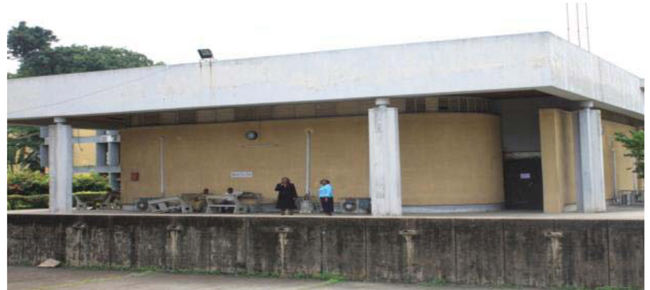 ) as one of the facilities referred to as an energy stock at the University of Lagos. The demand for energy within the educational facility is used for the operation of different energy systems, which include lighting, ventilation and air-conditioning, and appliances. Comprehensive energy audit procedure for the development of a reliable BEMS identifies two types of data gathering systems: (1) instruments for metering parameters like indoor temperature, relative humidity, etc; and (2) sensors integrated with building devices [6Nwaoga, J.A.; Okonkwo, W.I.; Unachukwu, G.O. Exploring the photo-sensitivities of Mimosa pudica for solar cell production. 26th European Photovoltaic Solar Energy Conference and Exhibition, 2011, 406-410.]. Similarity functions based on factors such as residents, space and power consumption in buildings are often used to develop a generalized domain grouping scheme [10Byun, J.; Hong, I.; Kang, B.; Park, S. A smart energy distribution and management system for renewable energy distribution and context-aware services based on user-patterns and load forecasting. IEEE Trans. Consum. Electron., 2011, 57(2), 436-444.
) as one of the facilities referred to as an energy stock at the University of Lagos. The demand for energy within the educational facility is used for the operation of different energy systems, which include lighting, ventilation and air-conditioning, and appliances. Comprehensive energy audit procedure for the development of a reliable BEMS identifies two types of data gathering systems: (1) instruments for metering parameters like indoor temperature, relative humidity, etc; and (2) sensors integrated with building devices [6Nwaoga, J.A.; Okonkwo, W.I.; Unachukwu, G.O. Exploring the photo-sensitivities of Mimosa pudica for solar cell production. 26th European Photovoltaic Solar Energy Conference and Exhibition, 2011, 406-410.]. Similarity functions based on factors such as residents, space and power consumption in buildings are often used to develop a generalized domain grouping scheme [10Byun, J.; Hong, I.; Kang, B.; Park, S. A smart energy distribution and management system for renewable energy distribution and context-aware services based on user-patterns and load forecasting. IEEE Trans. Consum. Electron., 2011, 57(2), 436-444.
[http://dx.doi.org/10.1109/TCE.2011.5955177] ]. The profile of various energy stock's electricity consumption is required for (a) developing tools for energy auditors; and (b) identifying possible operational and maintenance problems.
 |
Fig. (1) Sample of an energy stock: Engineering lecture theatre. |
The first Swedish load shape study on commercial and public buildings was carried out in 1987-1990. This study presents typical load shapes for approximately 40 different types of buildings, ranging from single-family houses to commercial and industrial buildings. The load shapes were presented in non-dimensional terms (related to annual electricity consumption). Several load shape studies have been performed at the Norwegian Research Institute of Energy Supply (EFI). However, these studies focus on buildings using electric resistance heating. The results are presented as relative load shapes in some cases, e.g., Feilberg and Livik [11Feilberg, N.; Livik, K. Energy and load structure at various categories of end users, 1993, EFI TR 4074]. Many studies have also been carried out in the USA by the Lawrence Berkeley National Laboratory and several other research groups. Multivariate regression is an effective technique that controls non-retrofit related factors that affect energy consumption. If the site data (all relevant explanatory variables, such as weather, occupancy, and operational schedules) are available and/or collected, the technique can result in more accurate and reliable savings estimates than a simple comparison of pre- and post-installation energy consumption [12Ogedengbe, E.O.B. Optimization of thermal and electrical appliance loads in residential and commercial buildings with demand side monitoring. Smart Grid Renew. Energy, 2013, 4(07), 16-26.
[http://dx.doi.org/10.4236/sgre.2013.47A003] ]. The use of the multivariate regression approach is dependent on and limited by the availability of site and billing data. The decision to use a regression analysis technique should be based on the availability of environmental and power data, in order to develop a reliable model for planning and design of an integrated renewable conversion energy system [13Ogedengbe, E.O.B.; Rosen, M.A. Electro-kinetic pumping with slip irreversibility in heat exchange of CSP-Powered bio-digester assemblies. Entropy (Basel), 2012, 14, 2439-2455.
[http://dx.doi.org/10.3390/e14122439] ].
Being compliant with the expected architecture of smart grid technology necessitates a paradigm shift from the conventional practice of restricting the operations of a BEMS to utilities. Consumers should be able to readily access a developed energy portal for dynamic monitoring and control of their usages towards an improved system efficiency. A web-based Consumer Energy Portal (CEP) was developed at the Nanyang Technological University (NTU) to provide a communication gateway between utilities and the consumers at the staff quarters for services such as electricity billing, Demand Response Management (DRM), Distributed Energy Resource (DER) management, etc [14Cheah, P.H.; Zhang, R.; Gooi, H.B.; Yu, H.; Foo, M.K. Consumer energy portal and home energy management system for smart grid applications 10th International Power and Energy Conference, 2012, , 407-411.
[http://dx.doi.org/10.1109/ASSCC.2012.6523302] ]. The CEP works by facilitating consumers data through the Data Concentration Unit (CDU) and engages the BEMS through the NTU Central Management System (CMS). In order to extend this technology to off-campus consumers, it appears many district CMSs must be installed in order to accommodate the entire population within the BEMS architecture. However, the deployment of the Digital Environment Home Energy Management System (DEHEMS) for electricity and gas monitoring in European-wide homes offers options for the large-scale practice of BEMS [15Liu, Q.; Cooper, G.; Linge, N.; Takruri, H.; Showden, R. DEHEMS: Creating a digital environment for large scale energy management at homes. IEEE Trans. Consum. Electron., 2013, 59(1), 62-69.
[http://dx.doi.org/10.1109/TCE.2013.6490242] ]. Using a four-layer system architecture, including perception, transport, processing and application layers, the DEHEMS allows users to explore and monitor their energy consumption and share the information with their online community for comparison and competition. Although the effectiveness of this method is attractive, the high cost of implementation involved will be difficult to sustain in a fully competitive energy market. In the fully deregulated Ontario energy market in Canada, Demand Side Monitoring (DSM) offers a cheaper alternative to DEHEMS for consumers of electricity and natural gas who retain a licensed service provider with the capability to offer consumption-derivative energy supply, instead of the conventional price-derivative service [12Ogedengbe, E.O.B. Optimization of thermal and electrical appliance loads in residential and commercial buildings with demand side monitoring. Smart Grid Renew. Energy, 2013, 4(07), 16-26.
[http://dx.doi.org/10.4236/sgre.2013.47A003] ]. The Ontario Electronic Business Transaction [16 Ontario EBT Working Group 2005, Electronic Business Transaction Standard Document for Retail Settlement in the Electric Retail Open Access Industry, version 3, February 2005.] (“EBT”) standard for electricity retailing and the EBT Data Transport Protocol [17 Ontario EBT Working Group 2005, EBT Data Transport Protocol, version 3, February 2005.] for natural gas marketing recommend the Public Key Infrastructure technology (“PKI”) as the key standard for ensuring EBT Internet security characteristics of privacy, authentication, integrity, and non-repudiation (“PAIN”). The Meter Data and Payments Transactions in Fig. (2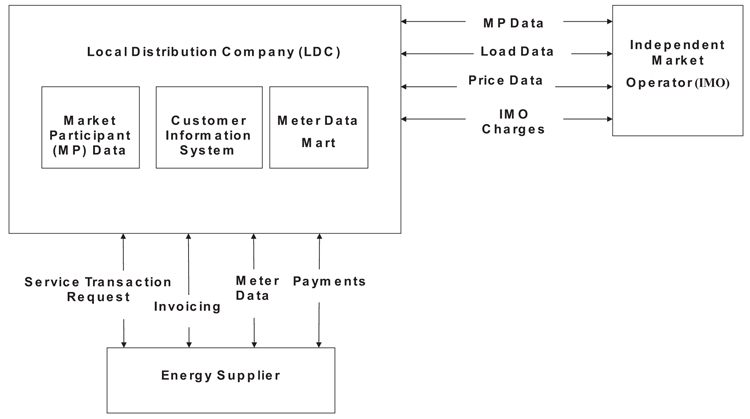 ) represent the required information in order to capture the historical consumption of every ESCo Client. The inclusion of the historical usage data, for up to 24 months, represents the significant contribution of this paper to the monitoring of energy commodities supplied to the energy stock. With the anticipated incorporation of time-of-use (“TOU”) information into the revised version of the EBT, following the standard “usage transaction” request between the energy supplier and utilities, sufficient data would be available for effective BEMS through DSM.
) represent the required information in order to capture the historical consumption of every ESCo Client. The inclusion of the historical usage data, for up to 24 months, represents the significant contribution of this paper to the monitoring of energy commodities supplied to the energy stock. With the anticipated incorporation of time-of-use (“TOU”) information into the revised version of the EBT, following the standard “usage transaction” request between the energy supplier and utilities, sufficient data would be available for effective BEMS through DSM.
 |
Fig. (2) Standard EBT communication protocol in Ontario, Canada. |
3. FLEXIBILITY OF ORGANIC PHOTOVOLTAIC SOLAR WAFERS
Concerns regarding the growing global energy needs and environmental impacts are driving efforts to develop energy conversion systems that have improved efficiency and that utilize solar energy resources as well as other types of renewable energy like biomass, hydro, wind, etc. Photovoltaic (PV) conversion converts solar energy into Direct Current (DC) electrical energy. The conversion efficiency of the conventional single-crystalline single-junction Si technology is generally reported to be below 30% [18Beard, M.C.; Ellingston, R.J. Multiple exciton generation in semi-conductor nanocrystals: Toward efficient solar energy conversion. Laser Photonics Rev., 2008, 2(5), 377-399.
[http://dx.doi.org/10.1002/lpor.200810013] ]. Other emerging PV technologies include multi-junction cells [19Yamaguchi, M. III-V Compound multi-junction solar cells: Present and future. Sol. Energy Mater. Sol. Cells, 2003, 75, 261-269.
[http://dx.doi.org/10.1016/S0927-0248(02)00168-X] ], optical frequency shifting [20Trupke, T.; Green, M.A.; Wurfel, P. Improving solar cell efficiencies by down-conversion of high energy protons. J. Appl. Phys., 2002, 92, 1668-1674.
[http://dx.doi.org/10.1063/1.1492021] ], multiple energy level cells [21Marti, A.; Luque, A. Next generation photovoltaic: High efficiency through spectrum utilization., 2003,
[http://dx.doi.org/10.1201/9781420033861] ] and concentrated PV systems [22Vicenzi, D.; Busato, A.; Stefancich, M.; Martinelli, G. Concentrating PV system based on spectral separation of solar radiation. Phys. Status Solidi., A Appl. Mater. Sci., 2009, 206, 375-378.
[http://dx.doi.org/10.1002/pssa.200824468] ], but these have not yet achieved full-scale commercial deployment. Yang and Yin [23Yang, D.; Yin, H. Energy conversion efficiency of a novel hybrid solar system for photovoltaic, thermoelectric, and heat utilization. IEEE Trans. Energ. Convers., 2011, 16(2), 662-670.
[http://dx.doi.org/10.1109/TEC.2011.2112363] ] recently proposed a novel hybrid solar system of PV, thermoelectric (TE) modules, and hot water (HW) systems through a multi-layered building envelope. However, the theoretical energy conversion efficiency of the system, which is superior to traditional PV systems and attains 30% greater output electrical power, are not observed to be significant based on experimental data due to the low efficiency of the bulk TE material. Other approaches for the combined utilization of renewable energy sources have been identified as attractive to designers of energy conversion systems [24Kurtulan, S.; Sevgi, L. A village house energy-supply system: Fundamentals of energy conversion. IEEE Antennas Propag. Mag., 2009, 51(4), 233-237.
[http://dx.doi.org/10.1109/MAP.2009.5338752] , 25Sarkar, S.; Ajjarapu, V.M.W. Resource assessment model for a hybrid energy conversion system with wind and solar resources. IEEE Trans. Sustain. Energ., 2011, 2(4), 383-391.
[http://dx.doi.org/10.1109/TSTE.2011.2148182] ].
The photovoltaic energy conversion process in the M. pudica based organic solar cell consists of four steps Fig. (3 ): light absorption, charge generation, charge transport, and charge collection. Light absorption occurs when the material has a semiconducting property that responds to incident waves [26Kim, M.S.; Kim, B.G.; Kim, J. Effective variables to control the fill factor of organic photovoltaic cells. ACS Appl. Mater. Interfaces, 2009, 1(6), 1264-1269.
): light absorption, charge generation, charge transport, and charge collection. Light absorption occurs when the material has a semiconducting property that responds to incident waves [26Kim, M.S.; Kim, B.G.; Kim, J. Effective variables to control the fill factor of organic photovoltaic cells. ACS Appl. Mater. Interfaces, 2009, 1(6), 1264-1269.
[http://dx.doi.org/10.1021/am900155y] [PMID: 20355922] ]. The absorption characteristic is dependent on the band gap of the semiconducting material and its intrinsic extinction coefficient. The charge generation period occurs when the incident photon strikes electrons at the ground state, and the inorganic semiconductors generate free carriers. However, in organic semiconductors, excited electrons slightly relax and then form an exciton (a bounded electron and hole pair). Once the excitons are dissociated, the charge transport process can occur, which involves the transport of dissociated charges to electrodes through charge transporting pathways. It has been shown that slip irreversibility represents a significant performance index in the transport of scalars, such as these dissociated charges, especially within the near-wall of a microfluidic transporting medium [27Ogedengbe, E.O.B.; Naterer, G.F.; Rosen, M.A. Slip flow irreversibility of dissipative kinetic and internal energy exchange in microchannels. J. Micromech. Microeng., 2006, 16(4), 2167-2176.
[http://dx.doi.org/10.1088/0960-1317/16/10/033] , 28Shitta, M.B.; Ogedengbe, E.O.B.; Rosen, M.A. Absorbance and thermal diffusion characteristics of charged ion in organic photovoltaic solar cell. Int. J. Proces. Syst. Eng., 2015, 3(4), 248-267.
[http://dx.doi.org/10.1504/IJPSE.2015.075109] ]. Removing this loss mechanism during the transport process can help improve cell performance. The final step is the charge collection, which occurs when the transported charges are collected from the semiconductor to the cathode or anode at the interface. When the interface is not carefully optimized, it can cause a dissipating sink of the transported charges.
 |
Fig. (3) Schematic structure of M. pudica based organic solar cell with network of microchannels. |
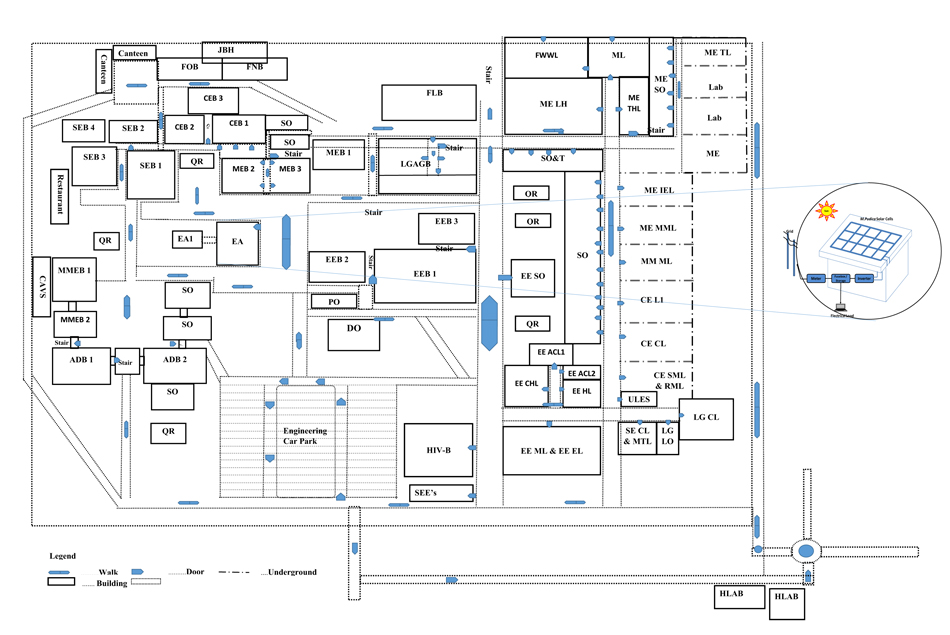 |
Fig. (4) Schematic of a Grid-connected M. pudica solar power system for the ELT at the Faculty of Engineering, University of Lagos. |
Organic Photovoltaic (OPV) cells have been proposed as a means to achieve low cost energy due to their ease of manufacture, light weight, and compatibility with flexible substrates. The cells, whose basic structure is illustrated in Fig. (3 ), are constructed by placing a layer of organic electronic materials between two metallic conductors [29Pandey, R.; Holmes, R.J. Organic photovoltaic cells based on continuously graded donor–acceptor heterojunctions. IEEE J. Sel. Top. Quantum Electron., 2010, 16(6), 1537-1543.
), are constructed by placing a layer of organic electronic materials between two metallic conductors [29Pandey, R.; Holmes, R.J. Organic photovoltaic cells based on continuously graded donor–acceptor heterojunctions. IEEE J. Sel. Top. Quantum Electron., 2010, 16(6), 1537-1543.
[http://dx.doi.org/10.1109/JSTQE.2010.2049256] ], typically a layer of Indium Tin Oxide (ITO) with a high work function and a layer of a low work function metal (e.g., Al, Mg, Ca). Recently, OPV effects have been examined in device structures of ITO/CuPc/Al and ITO/CuPc/C60/BCP/Al by varying the organic material layer thickness. It was discovered that, for the single-layered device, the layer thickness significantly affects device characteristics, possibly due to a relatively short exciton diffusion length. As the layer thickness increases, the current density decreases as expected, due to an increase in resistance of the layer. The overall behavior of these characteristics is observed to be nonlinear [30Choi, S.; Maruyama, S. Variations in the thermal conductivity of insulating thin films with temperature and pressure. J. Korean Phys. Soc., 2004, 45(4), 897-906.], but heat transfer across the boundary of the laminate from the organic material has not been considered. An assembly of suitably wafered M. pudica solar cells can provide a sustainable supply of solar power and be embedded in the grid power supply to the Faculty of Engineering (Fig. 4 ).
).
In a recent work of Shitta and Ogedengbe [2Shitta, M.B.; Ogedengbe, E.O.B. Performance modelling of Mimosa pudica extract as a sensitizer for solar energy conversion. Energ. Pol. Res., 2016, 3(1), 42-49.
[http://dx.doi.org/10.1080/23815639.2016.1255859] ], the appreciable performance of M. pudica sensitized organic solar cell shows the potential flexibility of organic solar wafers for power generation in buildings. Fig. (5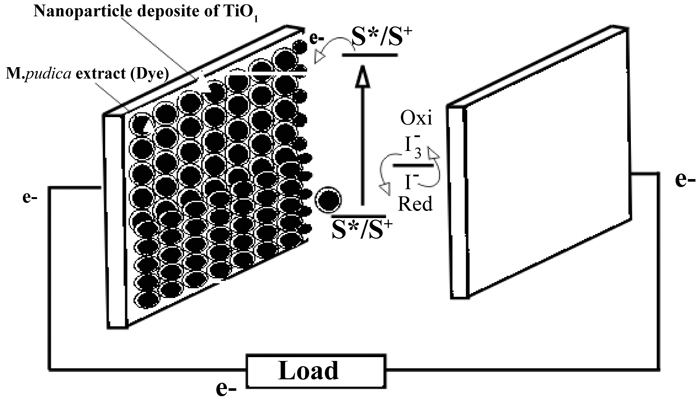 ) shows the schematics of the cell and the obtained conversion efficiency of samples of surface engineering with different self-assembly monolayers.
) shows the schematics of the cell and the obtained conversion efficiency of samples of surface engineering with different self-assembly monolayers.
 |
Fig. (5) Schematic of the organic solar cell with samples of ideal performance efficiencies. |
4. SLIP IRREVERSIBILITY PHENOMENON
Consider the transport of dissociated charges within the wafered M. pudica based organic solar cell as shown in Fig. (6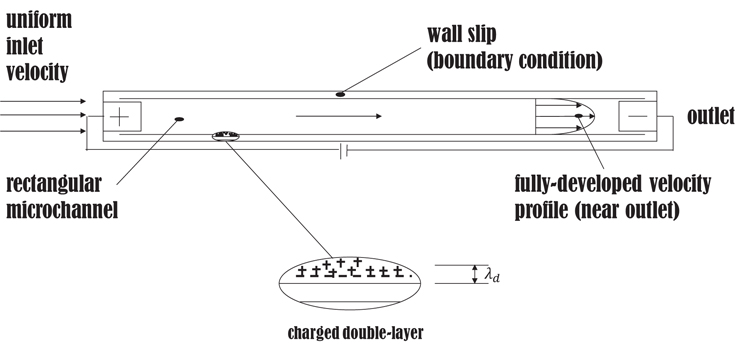 ), modelled as electrokinetic driven flow within a microchannel. Assuming incompressible flows, these scalar transport variables can be predicted based on the following [13Ogedengbe, E.O.B.; Rosen, M.A. Electro-kinetic pumping with slip irreversibility in heat exchange of CSP-Powered bio-digester assemblies. Entropy (Basel), 2012, 14, 2439-2455.
), modelled as electrokinetic driven flow within a microchannel. Assuming incompressible flows, these scalar transport variables can be predicted based on the following [13Ogedengbe, E.O.B.; Rosen, M.A. Electro-kinetic pumping with slip irreversibility in heat exchange of CSP-Powered bio-digester assemblies. Entropy (Basel), 2012, 14, 2439-2455.
[http://dx.doi.org/10.3390/e14122439] ]:
 |
(1) |
 |
(2) |
 |
(3) |
Where
 |
 |
Fig. (6) Schematic of electrokinetic driven flow within a microchannel. |
A finite volume formulation of the slip irreversibility phenomenon in a microfluidic device is described in detail elsewhere [13Ogedengbe, E.O.B.; Rosen, M.A. Electro-kinetic pumping with slip irreversibility in heat exchange of CSP-Powered bio-digester assemblies. Entropy (Basel), 2012, 14, 2439-2455.
[http://dx.doi.org/10.3390/e14122439] , 27Ogedengbe, E.O.B.; Naterer, G.F.; Rosen, M.A. Slip flow irreversibility of dissipative kinetic and internal energy exchange in microchannels. J. Micromech. Microeng., 2006, 16(4), 2167-2176.
[http://dx.doi.org/10.1088/0960-1317/16/10/033] ]. The triple-layer layout of a M. pudica based organic solar cell is the focus here. The middle layer (Fig. 3), which composed of the M.pudica extract, represents a two-dimensional region of unsteady temperature distribution. Each of these three layers is represented by unique geometrical and thermophysical properties.
Several reasonable assumptions are made here for simplicity of the model. These include: (1) no momentum transfer occurs within any of the triple-layer materials; (2) no mass transfer occurs within any of the triple-layer materials; (3) mass and heat transfer within the M. pudica extract occurs within a network of microchannels; and (4) perfect contact exists between each of the layers of the organic wafer.
5. NUMERICAL ANALYSIS AND RESULTS
Table 1 shows the thermophysical properties of the constituents in the layers of the organic solar cell, whose temperature distribution is presented in this section. The simulation for the temperature distribution and total heat flow within the M.pudica based organic solar cell are studied for varying external temperatures, ranging from an estimated minimum temperature (20oC) to an estimated maximum temperature (40oC), and for an organic layer thickness with and without source term [30Choi, S.; Maruyama, S. Variations in the thermal conductivity of insulating thin films with temperature and pressure. J. Korean Phys. Soc., 2004, 45(4), 897-906.]. As shown in Fig. (7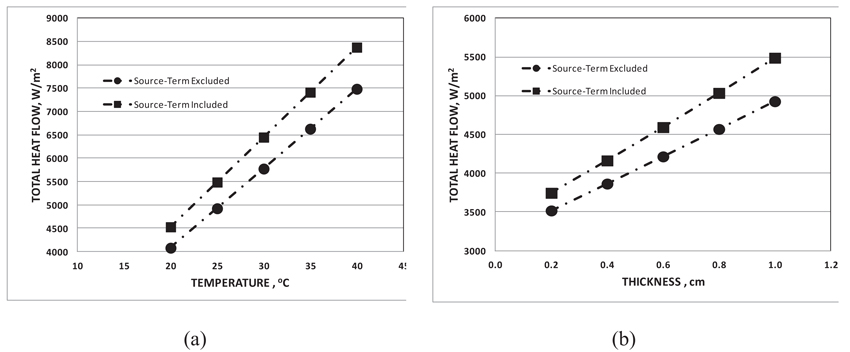 ), the total heat flow-rate in the organic material layer increases linearly with the environmental temperature and the thickness of the M.pudica based organic solar cell. Also, the total heat flow-rate with source term is greater than without the source term. Although the linearity of the source term effect is consistent with the adopted Joule heating model in Eqn. (4), the gradient of this effect increases independently with temperature and thickness of the M.pudica. The characteristics of creeping flow in macrostructures can be captured using Reynolds equations, where viscous effects play a dominant role in the understanding of the transport of dissociated charges through the M.pudica extract. However, slip irreversibility phenomena are relevant for flows within the microscale network of the channels that model a typical wafered organic solar cell. For instance, a gas flow in a microchannel with 10-3 > Kn > 10-1 predicts a reduction of the maximum velocity for the slip profile with increasing momentum accommodation coefficient, which appears to be due to the thermal-kinetic energy exchange at the boundary of the microchannels Fig. (8
), the total heat flow-rate in the organic material layer increases linearly with the environmental temperature and the thickness of the M.pudica based organic solar cell. Also, the total heat flow-rate with source term is greater than without the source term. Although the linearity of the source term effect is consistent with the adopted Joule heating model in Eqn. (4), the gradient of this effect increases independently with temperature and thickness of the M.pudica. The characteristics of creeping flow in macrostructures can be captured using Reynolds equations, where viscous effects play a dominant role in the understanding of the transport of dissociated charges through the M.pudica extract. However, slip irreversibility phenomena are relevant for flows within the microscale network of the channels that model a typical wafered organic solar cell. For instance, a gas flow in a microchannel with 10-3 > Kn > 10-1 predicts a reduction of the maximum velocity for the slip profile with increasing momentum accommodation coefficient, which appears to be due to the thermal-kinetic energy exchange at the boundary of the microchannels Fig. (8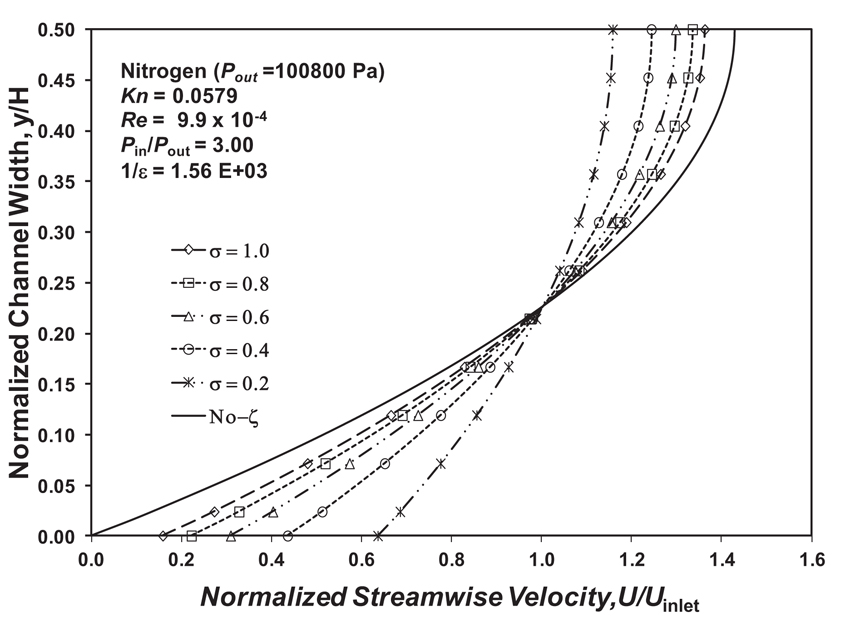 ). Considering a steady heat flow at a specified temperature and the thickness of the organic layer, it appears that the slip irreversibility may contribute positively to the required energy conversion for effective transport of dissociated excitrons across the network of microchannels. The discharge approaches a fully developed flow profile as the momentum accommodation is varied increasingly from 0.2 to 1.0. However, the slip irreversibility region appears to be bounded by an asymptotic near-wall layer (y/H = 0.214) from the boundary of the microchannel.
). Considering a steady heat flow at a specified temperature and the thickness of the organic layer, it appears that the slip irreversibility may contribute positively to the required energy conversion for effective transport of dissociated excitrons across the network of microchannels. The discharge approaches a fully developed flow profile as the momentum accommodation is varied increasingly from 0.2 to 1.0. However, the slip irreversibility region appears to be bounded by an asymptotic near-wall layer (y/H = 0.214) from the boundary of the microchannel.
 |
Fig. (7) Distribution of the total heat flow-rate in the M. pudica based organic solar cell with (a) Temperature; and (b) the Thickness of the M.pudica Layer. |
Tables 2 and 3 show the physical properties and the electrical load distribution respectively of the elements constituting the energy stock, the Engineering Lecture Theatre (ELT). A multiple regression approach is used to develop a model that captures the Overall Thermal Transfer value (OTTV) of the energy stock. The OTTV is a thermal transfer function obtained from the collection of the load shape exposures on walls and floors of the ELT, and represents a measure of energy consumption of the building envelope [31Bakare, A.; Ogedengbe, E.O.B. Load shape extrapolation and multiple regression of energy stocks within the university of lagos AIAA Collection of Technical Papers, 2013.14-17 Jul11th International Energy Conversion Engineering Conference (IECEC) AIAASan Jose, California 2013-3939]. The predicted annual energy results obtained from the simulation tool are correlated with the architectural variables and the internal load density of the Engineering Lecture Theatre in order to obtain the regression coefficients for the following:
 |
(4) |
where the regression coefficients, bi, can be obtained for all the energy stocks within the service area. By incorporating the sensitivity of the M. pudica based organic solar cell, including the total heat transport with temperature, thickness of the M. pudica layer, and other parametric studies which are detailed elsewhere [32Alonge, O.J.; Ogedengbe, E.O.B. Heat transfer and charge transport characterization of organic wafering with photo-sensitive mimosa pudica extract AIAA Collection of Technical Papers,, 2013. 14 -17 Jul11th International Energy Conversion Engineering Conference (IECEC) AIAASan Jose, California 2013-3740], into the regression table, an additional regression coefficient is anticipated to capture the contribution of energy supply for comprehensive demand-supply energy management for the ELT.
CONCLUSION
The flexibility of M. pudica based organic solar cell for photovoltaic energy conversion and management is investigated. Demand side monitoring of energy consumption in Engineering Lecture Theatre of the University of Lagos is conducted in order to obtain the load shape characteristic of the energy stock, using multiple regression analysis. Slip irreversibility appears to have a significant effect on the transport of the dissipated excitrons within the network of microchannels, especially within an asymptotic near-wall layer bounded by the discharge interface at y/H=0.214 from the channel wall for all values of the momentum accommodation coefficients. The linear relationship between the heat flow rate and the thickness and temperature provides a significant guide to the selection of the appropriate wafering technology for OPV Cells. Results of surface engineering experiment of the control solar cell with different self-assembly monolayers show that optimal performance of 0.85% is obtained with the use of oxidised starch. Additional investigations of the back field effect on the wafering technology and the optimization of the energy conversion within the M. pudica based organic solar cell appear to be merited to obtain a comprehensive energy conversion and management tool.
CONSENT FOR PUBLICATION
Not applicable.
CONFLICT OF INTEREST
The authors declare no conflict of interest, financial or otherwise.
ACKNOWLEDGEMENTS
Declared none.
REFERENCES
| [1] | Palenky, P.; Dietrich, D. Demand side management: Demand response, intelligent energy systems, and smart loads. IEEE Trans. Industr. Inform., 2011, 7(3), 381-388. [http://dx.doi.org/10.1109/TII.2011.2158841] |
| [2] | Shitta, M.B.; Ogedengbe, E.O.B. Performance modelling of Mimosa pudica extract as a sensitizer for solar energy conversion. Energ. Pol. Res., 2016, 3(1), 42-49. [http://dx.doi.org/10.1080/23815639.2016.1255859] |
| [3] | Ghosh, R.; Biswas, S.; Roy, S. An apyrase from Mimosa pudica contains N5, N10-methenyl tetrahydrofolate and is stimulated by light. Eur. J. Biochem., 1998, 258(3), 1009-1013. [http://dx.doi.org/10.1046/j.1432-1327.1998.2581009.x] [PMID: 9990319] |
| [4] | Kumon, K.; Suda, S. Ionic fluxes from pulvinar cells during the rapid movement of Mimosa pudica L. Plant Cell Physiol., 1984, 25(6), 975-979. |
| [5] | Samejima, M.; Sibaoka, T. Changes in the extracellular ion concentration in the main pulvinus of Mimosa pudica during rapid movement and recovery. Plant Cell Physiol., 1980, 21(3), 467-479. |
| [6] | Nwaoga, J.A.; Okonkwo, W.I.; Unachukwu, G.O. Exploring the photo-sensitivities of Mimosa pudica for solar cell production. 26th European Photovoltaic Solar Energy Conference and Exhibition, 2011, 406-410. |
| [7] | Ogedengbe, E.O.B.; Igbekoyi, O.; Khalil, E.E. Analysis of electricity consumption in the Faculty of Engineering with Integration of Renewable Solar Power System AIAA Collection of Technical Papers, 2012.30 Jul - 1 Aug10th International Energy Conversion Engineering Conference (IECEC), AIAAAtlanta 4247 |
| [8] | Ogedengbe, E.O.B.; Kraehling, D.; Adem, Z.A. Demand Side Monitoring of Energy Systems in Ontario’s Residential and Commercial Sectors 31 July - 03 August 2011, 9th Annual International Energy Conversion Engineering Conference, AIAA San Diego, California. 2011-5871 |
| [9] | Ma, X.; Cui, R.; Sun, Y.; Peng, C.; Wu, Z. Supervisory and Energy Management System of Large Public Buildings Proceedings of the 2010 IEEE International Conference on Mechatronics and Automation, 2010,. Xi'an, China August 4-7 pp. 928-33 [http://dx.doi.org/10.1109/ICMA.2010.5589969] |
| [10] | Byun, J.; Hong, I.; Kang, B.; Park, S. A smart energy distribution and management system for renewable energy distribution and context-aware services based on user-patterns and load forecasting. IEEE Trans. Consum. Electron., 2011, 57(2), 436-444. [http://dx.doi.org/10.1109/TCE.2011.5955177] |
| [11] | Feilberg, N.; Livik, K. Energy and load structure at various categories of end users, 1993, EFI TR 4074 |
| [12] | Ogedengbe, E.O.B. Optimization of thermal and electrical appliance loads in residential and commercial buildings with demand side monitoring. Smart Grid Renew. Energy, 2013, 4(07), 16-26. [http://dx.doi.org/10.4236/sgre.2013.47A003] |
| [13] | Ogedengbe, E.O.B.; Rosen, M.A. Electro-kinetic pumping with slip irreversibility in heat exchange of CSP-Powered bio-digester assemblies. Entropy (Basel), 2012, 14, 2439-2455. [http://dx.doi.org/10.3390/e14122439] |
| [14] | Cheah, P.H.; Zhang, R.; Gooi, H.B.; Yu, H.; Foo, M.K. Consumer energy portal and home energy management system for smart grid applications 10th International Power and Energy Conference, 2012, , 407-411. [http://dx.doi.org/10.1109/ASSCC.2012.6523302] |
| [15] | Liu, Q.; Cooper, G.; Linge, N.; Takruri, H.; Showden, R. DEHEMS: Creating a digital environment for large scale energy management at homes. IEEE Trans. Consum. Electron., 2013, 59(1), 62-69. [http://dx.doi.org/10.1109/TCE.2013.6490242] |
| [16] | Ontario EBT Working Group 2005, Electronic Business Transaction Standard Document for Retail Settlement in the Electric Retail Open Access Industry, version 3, February 2005. |
| [17] | Ontario EBT Working Group 2005, EBT Data Transport Protocol, version 3, February 2005. |
| [18] | Beard, M.C.; Ellingston, R.J. Multiple exciton generation in semi-conductor nanocrystals: Toward efficient solar energy conversion. Laser Photonics Rev., 2008, 2(5), 377-399. [http://dx.doi.org/10.1002/lpor.200810013] |
| [19] | Yamaguchi, M. III-V Compound multi-junction solar cells: Present and future. Sol. Energy Mater. Sol. Cells, 2003, 75, 261-269. [http://dx.doi.org/10.1016/S0927-0248(02)00168-X] |
| [20] | Trupke, T.; Green, M.A.; Wurfel, P. Improving solar cell efficiencies by down-conversion of high energy protons. J. Appl. Phys., 2002, 92, 1668-1674. [http://dx.doi.org/10.1063/1.1492021] |
| [21] | Marti, A.; Luque, A. Next generation photovoltaic: High efficiency through spectrum utilization., 2003, [http://dx.doi.org/10.1201/9781420033861] |
| [22] | Vicenzi, D.; Busato, A.; Stefancich, M.; Martinelli, G. Concentrating PV system based on spectral separation of solar radiation. Phys. Status Solidi., A Appl. Mater. Sci., 2009, 206, 375-378. [http://dx.doi.org/10.1002/pssa.200824468] |
| [23] | Yang, D.; Yin, H. Energy conversion efficiency of a novel hybrid solar system for photovoltaic, thermoelectric, and heat utilization. IEEE Trans. Energ. Convers., 2011, 16(2), 662-670. [http://dx.doi.org/10.1109/TEC.2011.2112363] |
| [24] | Kurtulan, S.; Sevgi, L. A village house energy-supply system: Fundamentals of energy conversion. IEEE Antennas Propag. Mag., 2009, 51(4), 233-237. [http://dx.doi.org/10.1109/MAP.2009.5338752] |
| [25] | Sarkar, S.; Ajjarapu, V.M.W. Resource assessment model for a hybrid energy conversion system with wind and solar resources. IEEE Trans. Sustain. Energ., 2011, 2(4), 383-391. [http://dx.doi.org/10.1109/TSTE.2011.2148182] |
| [26] | Kim, M.S.; Kim, B.G.; Kim, J. Effective variables to control the fill factor of organic photovoltaic cells. ACS Appl. Mater. Interfaces, 2009, 1(6), 1264-1269. [http://dx.doi.org/10.1021/am900155y] [PMID: 20355922] |
| [27] | Ogedengbe, E.O.B.; Naterer, G.F.; Rosen, M.A. Slip flow irreversibility of dissipative kinetic and internal energy exchange in microchannels. J. Micromech. Microeng., 2006, 16(4), 2167-2176. [http://dx.doi.org/10.1088/0960-1317/16/10/033] |
| [28] | Shitta, M.B.; Ogedengbe, E.O.B.; Rosen, M.A. Absorbance and thermal diffusion characteristics of charged ion in organic photovoltaic solar cell. Int. J. Proces. Syst. Eng., 2015, 3(4), 248-267. [http://dx.doi.org/10.1504/IJPSE.2015.075109] |
| [29] | Pandey, R.; Holmes, R.J. Organic photovoltaic cells based on continuously graded donor–acceptor heterojunctions. IEEE J. Sel. Top. Quantum Electron., 2010, 16(6), 1537-1543. [http://dx.doi.org/10.1109/JSTQE.2010.2049256] |
| [30] | Choi, S.; Maruyama, S. Variations in the thermal conductivity of insulating thin films with temperature and pressure. J. Korean Phys. Soc., 2004, 45(4), 897-906. |
| [31] | Bakare, A.; Ogedengbe, E.O.B. Load shape extrapolation and multiple regression of energy stocks within the university of lagos AIAA Collection of Technical Papers, 2013.14-17 Jul11th International Energy Conversion Engineering Conference (IECEC) AIAASan Jose, California 2013-3939 |
| [32] | Alonge, O.J.; Ogedengbe, E.O.B. Heat transfer and charge transport characterization of organic wafering with photo-sensitive mimosa pudica extract AIAA Collection of Technical Papers,, 2013. 14 -17 Jul11th International Energy Conversion Engineering Conference (IECEC) AIAASan Jose, California 2013-3740 |





